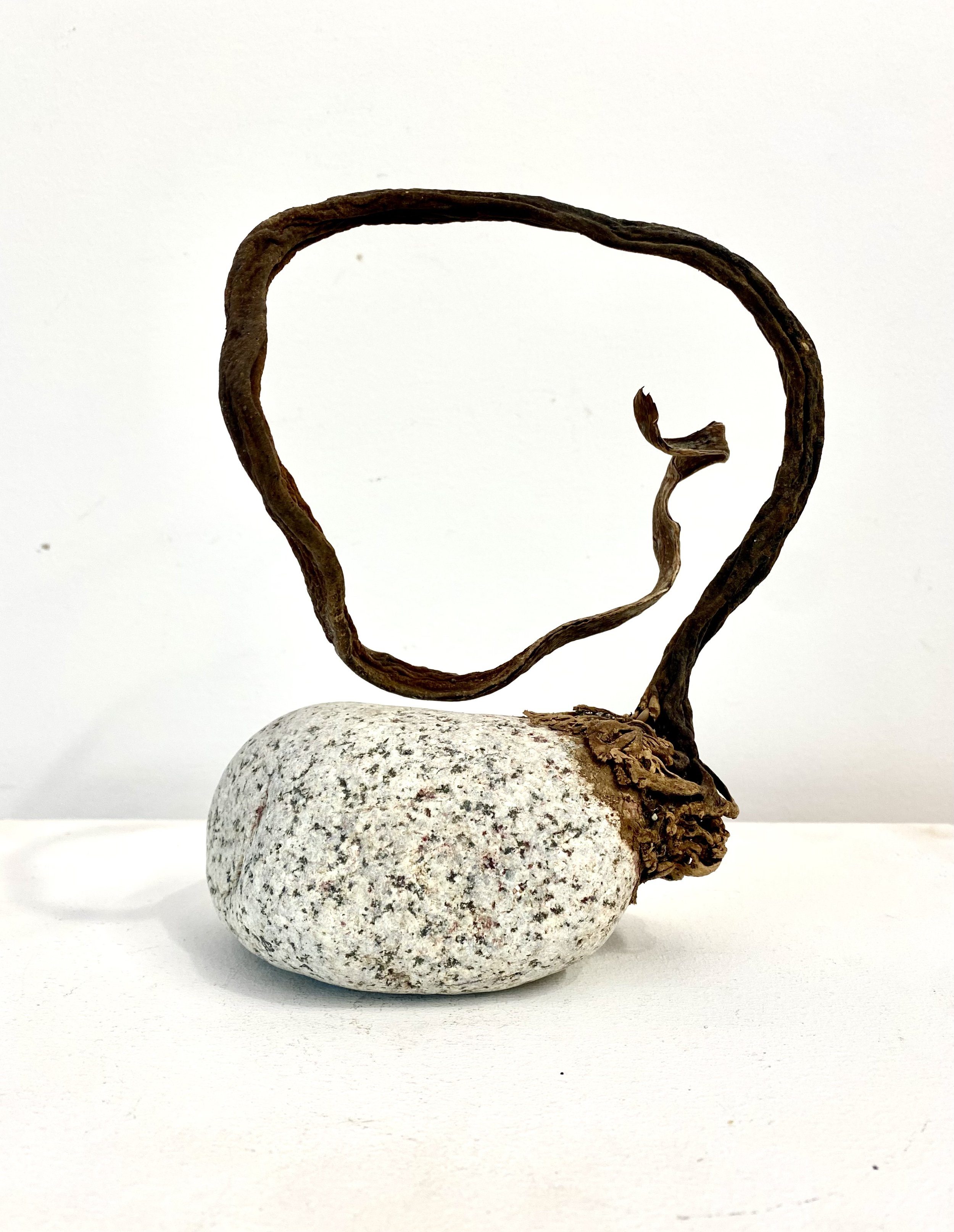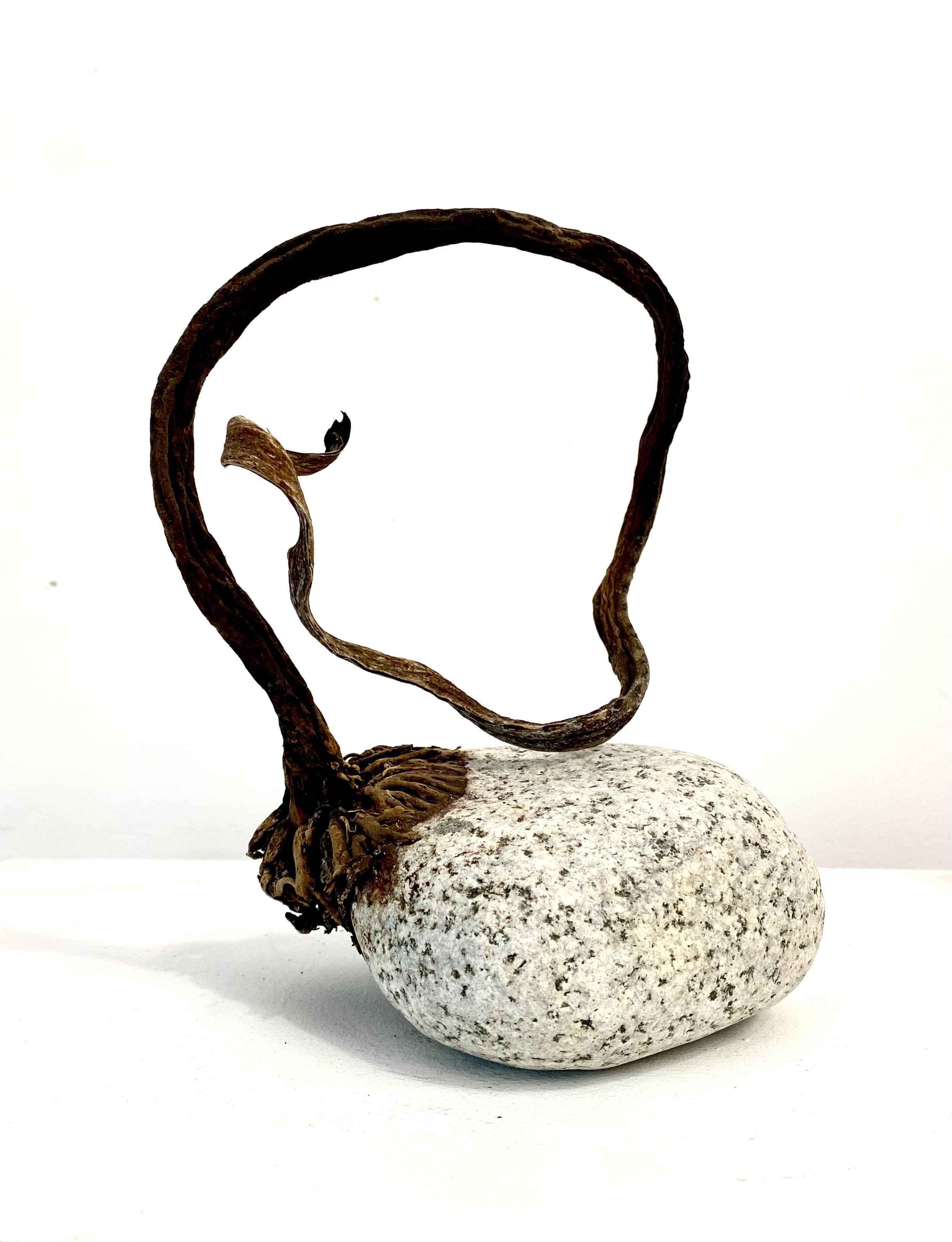 Image 1 of 2
Image 1 of 2

 Image 2 of 2
Image 2 of 2



Konbu Ensō Form
For your consideration, another sculptural object from Mother Nature. A dried stock of seaweed, still clutching a granite cobble with its root-like holdfast. It unintentionally re-creates the ensō (円相, "circular form"), an essential shape in Zen Buddhist calligraphy. Among many other things, the ensō represents a “pure” gesture, created in an instant, without too much thought.
The seaweed in question is the Southern stiff-stiped kelp, Laminaria setchellii, native to the Rocky open coast of the Pacific Northwest. In Japan, kelp in the genus Laminaria Is called konbu (昆布, also kombu). In Korean, it is known as dasima (다시마), and in China as haidai (海带). There are numerous species, all edible. Konbu is s the essential ingredient in dashi, the ubiquitous broth used in Japanese cooking.
In 1908, scientist Kikunae Ikeda was experimenting with kombu, seeking to discover why dashi is so darn tasty. He determined that the glutamic acid in kombu was responsible for its distinct taste, one that differed from the sweet, sour, bitter, and salty tastes then known to physiology. Ikeda called this new taste "umami" (うま味), from the Japanese word umai —"delicious".
But wait! There's even more to this modest-appearing seaweed. Its stems are used as in obstetrics and gynecology as an osmotic (or hygroscopic) dilator. In order to induce labor (or for other surgical procedures), "Laminaria sticks" are introduced into the cervix, where they slowly expand as they absorb fluid from surrounding tissue. This makes it one of the few natural materials still used in modern medicine.
For your consideration, another sculptural object from Mother Nature. A dried stock of seaweed, still clutching a granite cobble with its root-like holdfast. It unintentionally re-creates the ensō (円相, "circular form"), an essential shape in Zen Buddhist calligraphy. Among many other things, the ensō represents a “pure” gesture, created in an instant, without too much thought.
The seaweed in question is the Southern stiff-stiped kelp, Laminaria setchellii, native to the Rocky open coast of the Pacific Northwest. In Japan, kelp in the genus Laminaria Is called konbu (昆布, also kombu). In Korean, it is known as dasima (다시마), and in China as haidai (海带). There are numerous species, all edible. Konbu is s the essential ingredient in dashi, the ubiquitous broth used in Japanese cooking.
In 1908, scientist Kikunae Ikeda was experimenting with kombu, seeking to discover why dashi is so darn tasty. He determined that the glutamic acid in kombu was responsible for its distinct taste, one that differed from the sweet, sour, bitter, and salty tastes then known to physiology. Ikeda called this new taste "umami" (うま味), from the Japanese word umai —"delicious".
But wait! There's even more to this modest-appearing seaweed. Its stems are used as in obstetrics and gynecology as an osmotic (or hygroscopic) dilator. In order to induce labor (or for other surgical procedures), "Laminaria sticks" are introduced into the cervix, where they slowly expand as they absorb fluid from surrounding tissue. This makes it one of the few natural materials still used in modern medicine.
For your consideration, another sculptural object from Mother Nature. A dried stock of seaweed, still clutching a granite cobble with its root-like holdfast. It unintentionally re-creates the ensō (円相, "circular form"), an essential shape in Zen Buddhist calligraphy. Among many other things, the ensō represents a “pure” gesture, created in an instant, without too much thought.
The seaweed in question is the Southern stiff-stiped kelp, Laminaria setchellii, native to the Rocky open coast of the Pacific Northwest. In Japan, kelp in the genus Laminaria Is called konbu (昆布, also kombu). In Korean, it is known as dasima (다시마), and in China as haidai (海带). There are numerous species, all edible. Konbu is s the essential ingredient in dashi, the ubiquitous broth used in Japanese cooking.
In 1908, scientist Kikunae Ikeda was experimenting with kombu, seeking to discover why dashi is so darn tasty. He determined that the glutamic acid in kombu was responsible for its distinct taste, one that differed from the sweet, sour, bitter, and salty tastes then known to physiology. Ikeda called this new taste "umami" (うま味), from the Japanese word umai —"delicious".
But wait! There's even more to this modest-appearing seaweed. Its stems are used as in obstetrics and gynecology as an osmotic (or hygroscopic) dilator. In order to induce labor (or for other surgical procedures), "Laminaria sticks" are introduced into the cervix, where they slowly expand as they absorb fluid from surrounding tissue. This makes it one of the few natural materials still used in modern medicine.